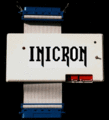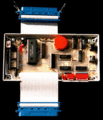Difference between revisions of "Inicron ROM-RAM-Box"
m (→Download) |
|||
| Line 1: | Line 1: | ||
[[Image:Inicron.gif|right|thumb|250px|Inicron logo]] | [[Image:Inicron.gif|right|thumb|250px|Inicron logo]] | ||
| − | '''Inicron's ROM-RAM-Box''' is a external device connected to the expansion port(with pass-trough), that provides 512 KB Pseudo-ROM. | + | '''Inicron's ROM-RAM-Box''' is a external device connected to the expansion port(with pass-trough), that provides 512 KB Pseudo-ROM. It was the very first of it's kind and opened the possibility of developing software for ROMs to every user. |
== Technical specs. == | == Technical specs. == | ||
| − | + | Inicron produced 128 KB, 256 KB and 512 KB ROM-RAM-Boxes. They used S-RAM to simulate ROMs. The S-RAM is buffered by an accumulator, that is charged by the CPC. Uncharged the contents of the Pseudo-ROMs remain stable for at least one year. However, in case of few DIY kits RAMs were used which consumed more energy which shortened the time of data retention. The advantage of using S-RAM is that one can reprogram the pseudo-ROM as often as needed. | |
| − | Inicron produced 128 KB and 512 KB ROM-RAM-Boxes. | + | |
== Pictures == | == Pictures == | ||
| − | |||
<gallery caption="The Inicron ROM-RAM-Box"> | <gallery caption="The Inicron ROM-RAM-Box"> | ||
Image:Rrb-mit.gif|The box | Image:Rrb-mit.gif|The box | ||
Latest revision as of 15:07, 7 January 2018
Inicron's ROM-RAM-Box is a external device connected to the expansion port(with pass-trough), that provides 512 KB Pseudo-ROM. It was the very first of it's kind and opened the possibility of developing software for ROMs to every user.
Technical specs.
Inicron produced 128 KB, 256 KB and 512 KB ROM-RAM-Boxes. They used S-RAM to simulate ROMs. The S-RAM is buffered by an accumulator, that is charged by the CPC. Uncharged the contents of the Pseudo-ROMs remain stable for at least one year. However, in case of few DIY kits RAMs were used which consumed more energy which shortened the time of data retention. The advantage of using S-RAM is that one can reprogram the pseudo-ROM as often as needed.
Pictures
- The Inicron ROM-RAM-Box
Software
Inicron delivered the RRB with the Softbrenner Tool. This ROM based software is window driven and allows to manage the RRB. It is even able to convert BASIC or Binary programs to ROMs.
TFM made an Autoinstaller for the Softbrenner ROM:
The automatic Installer of FutureOS also supports the ROM-RAM-Box. Furthermore the application ROManager does also support the RRB.
Download
- Booster ROM (Automatically initialises ROMs 16 to 31 when installed in position 15)


